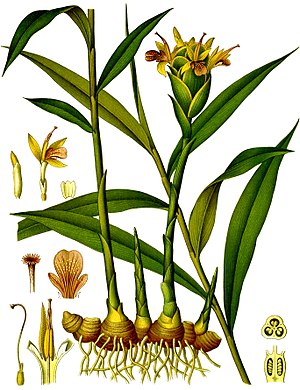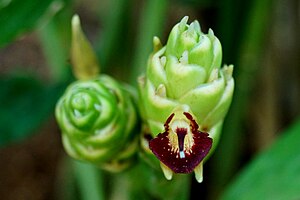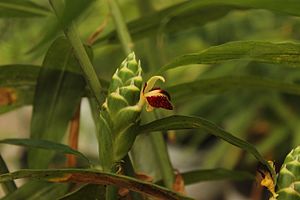Ginger/ja: Difference between revisions
Created page with "ショウガが輸出される州は、インドの野菜流通経路に従っており、その手順は国内輸送の場合と類似している。ただし、地域転送センターの後に最終市場に到達する代わりに、生産物は輸出市場に到着し、その後、車両、飛行機、または船で最終的な国際目的地に送られ、現地の小売市場に到着し、購入されると最終的に消費者の手に渡る。" |
Created page with "インドは世界最大のショウガ生産国であるにもかかわらず、主要な輸出国としての役割を果たしておらず、ショウガの総輸出量の約1.17%しか占めていない。インドにおけるショウガ栽培は費用がかかり、リスクの高い事業である。農家は輸出から多くの利益を得られず、「発生する総コストの65%以上が労働費と種子材料購入費に費やされている」。生産..." |
||
| Line 96: | Line 96: | ||
ショウガが輸出される州は、インドの野菜流通経路に従っており、その手順は国内輸送の場合と類似している。ただし、地域転送センターの後に最終市場に到達する代わりに、生産物は輸出市場に到着し、その後、車両、飛行機、または船で最終的な国際目的地に送られ、現地の小売市場に到着し、購入されると最終的に消費者の手に渡る。 | ショウガが輸出される州は、インドの野菜流通経路に従っており、その手順は国内輸送の場合と類似している。ただし、地域転送センターの後に最終市場に到達する代わりに、生産物は輸出市場に到着し、その後、車両、飛行機、または船で最終的な国際目的地に送られ、現地の小売市場に到着し、購入されると最終的に消費者の手に渡る。 | ||
乾燥ショウガは、小規模な小売店のネットワークを含む独自の流通システムを通じて、アジア諸国間で最も盛んに取引されている。生姜と保存されたショウガは、しばしばスーパーマーケットチェーンに直接販売され、一部の国では、生姜は特定の民族コミュニティに特有の小さな店でしか見られない。インドは頻繁にショウガや他の野菜を近隣のパキスタンやバングラデシュ、また「サウジアラビア、アラブ首長国連邦、モロッコ、米国、イエメン共和国、英国、オランダ」に輸出している。 | |||
インドは世界最大のショウガ生産国であるにもかかわらず、主要な輸出国としての役割を果たしておらず、ショウガの総輸出量の約1.17%しか占めていない。インドにおけるショウガ栽培は費用がかかり、リスクの高い事業である。農家は輸出から多くの利益を得られず、「発生する総コストの65%以上が労働費と種子材料購入費に費やされている」。生産量の損失や価格の下落がなければ、農家は利益を得られる可能性があるが、これらを回避することは容易ではない。純粋な単一作物としてではなく、間作システムで栽培されたショウガや、乾燥ショウガの生産は、より高い費用対効果を示すことが分かっている。 | |||
<div lang="en" dir="ltr" class="mw-content-ltr"> | <div lang="en" dir="ltr" class="mw-content-ltr"> | ||
Revision as of 19:58, 8 June 2025
| Ginger/ja | |
|---|---|

| |
| Köhler's Medicinal Plants から1896年のカラープレート | |

| |
| 花序 | |
| Scientific classification | |
| Kingdom: | Plantae |
| Clade: | Tracheophytes |
| Clade: | Angiosperms |
| Clade: | Monocots |
| Clade: | Commelinids |
| Order: | Zingiberales |
| Family: | Zingiberaceae |
| Genus: | Zingiber |
| Species: | officinale
|
| Binomial name | |
| officinale | |
ショウガ(学名:Zingiber officinale)は、ショウガ科の顕花植物である。その根茎は、ginger root|ショウガ根またはショウガとして、香辛料や民間療法に広く用いられている。高さ約1メートルの年間の偽茎(葉の巻き付いた基部でできた偽の茎)を伸ばし、細い葉身をつける草本の多年草である。花序には、淡い黄色の花弁に紫色の縁取りのある花がつき、根茎から直接、別のシュートとして生じる。
ショウガはショウガ科に属し、ウコン(Curcuma longa)、カルダモン(Elettaria cardamomum)、ガランガルなども含まれる。ショウガは海洋東南アジアを原産とし、おそらくオーストロネシア語族によって最初に栽培化された。オーストロネシア人の拡散(c. 5,000 BP)の間にインド太平洋全体に彼らとともに運ばれ、遠くハワイにまで到達した。ショウガはアジアから輸出された最初の香辛料の一つであり、香辛料貿易によってヨーロッパに伝わり、古代ギリシャ人や古代ローマ人に利用された。遠縁の双子葉植物であるAsarumは、その類似した味から一般的にワイルドジンジャーと呼ばれる。
ショウガは、中国、インド、日本で何世紀にもわたって伝統医学に、また現代では栄養補助食品として利用されてきた。ショウガは妊娠中の吐き気や嘔吐に対してプラセボよりも効果がある可能性があるが、化学療法中の吐き気に効果があるという良い証拠はない。ショウガがあらゆる病気の治療に効果があるかどうかは不明である。2023年の世界のショウガ生産量は490万トンで、インドが全体の45%を占め、首位であった。
語源
「ショウガ」(ginger)という英単語は、14世紀半ばに古英語の「gingifer」に由来します。これはさらに中世ラテン語の「gingiber」から来ており、この「gingiber」はギリシャ語の「ζιγγίβερις (zingiberis)」に、そしてそれはプラークリット(中期インド・アーリア語)の「siṅgabera」に、最終的にはサンスクリット語の「śṛṅgavera」に由来するとされている。 このサンスクリット語は、古代のドラヴィダ語に由来すると考えられており、タミル語やマラヤーラム語の「iñci-vēr」(「vēr」は「根」の意)という言葉も生み出した。 別の説としては、サンスクリット語の「srngam」(「角」の意)と「vera」(「体」の意)に由来し、その根の形を表しているというものがありますが、これは民間語源である可能性も指摘されている。 この単語は、おそらく中英語で古フランス語の「gingibre」(現代フランス語では「gingembre」)から再導入されたと考えられています。
起源と分布


ショウガは海洋東南アジアを原産とする。真の栽培植物であり、野生状態では存在しない。その最も古い栽培の証拠は、オーストロネシア語族の間で発見されており、古代から栽培・利用されてきたショウガ科植物のいくつかの種の一つであった。彼らはウコン(Curcuma longa)、ハナショウガ(Curcuma zedoaria)、ハナショウガ(Zingiber zerumbet)など、他のショウガも栽培していた。根茎や葉は食品の風味付けに使われたり、直接食べられたりした。葉は敷物を織るためにも使われた。これらの用途以外にも、ショウガはオーストロネシア人の間で宗教的な意味合いを持ち、癒しや精霊からの保護を求める儀式に使われた。また、オーストロネシアの船の祝福にも使われた。
ショウガは、約5,000BPから始まったオーストロネシア人の拡散の航海において、カヌー植物として彼らと共に運ばれた。彼らは他の文明との接触よりもはるか以前の有史以前に、ショウガを太平洋諸島に導入した。マレー・ポリネシア祖語の「*laqia」の反映形は、ハワイに至るまでのオーストロネシア語族の言語に見られる。彼らはまた、約3,500BPにオーストロネシアの船乗りがスリランカや南インドのドラヴィダ語を話す人々と初期接触した際に、他の東南アジアの食用植物やオーストロネシアの航海技術と共に、インドにも導入したと推定されている。紀元1千年紀には、オーストロネシアの航海者によってマダガスカルやコモロにも運ばれた。
インドからは、紀元1世紀頃までに商人によって中東や地中海へと運ばれた。香辛料貿易の期間中、コショウ、クローブ、その他多数の香辛料と共に、主に南インドや大スンダ列島で栽培された。
歴史
ショウガに関する最初の文献記録は、中国の戦国時代(紀元前475年-紀元前221年)に孔子の弟子たちによって書かれた『論語』に見られる。そこには、孔子が毎食ショウガを食べていたと記されている。406年には、僧侶の法顕が、ショウガが鉢植えで栽培され、壊血病を防ぐために中国の船に積まれて運ばれたと記している。宋王朝(960年-1279年)の時代には、ショウガは南方諸国から中国に輸入されていた。
ショウガの香辛料はアラブ人によって地中海に伝えられ、ディオスコリデス(40年-90年)や大プリニウス(24年-79年)などの著述家によって記述された。150年には、プトレマイオスがセイロン島(スリランカ)でショウガが生産されていると記している。ショウガは、その近縁種であるガランガルとともに、ローマ帝国に非常に高価な生薬の一部として輸入され、裕福な者だけが腎臓病などの治療に利用できた。アエティウス・アミデンシスは、彼の複雑な生薬処方にショウガとガランガルの両方が含まれていることを記述している。中世になると、ヨーロッパ人の食の好みがショウガの料理特性に好意的に変化したため、生姜と保存されたショウガのヨーロッパへの輸入量が増加した。この間、ショウガはいくつかの国の公式な薬局方に記載された。14世紀のイングランドでは、1ポンドのショウガは羊1頭と同じくらいの価格であった。
北西ヨーロッパにおけるショウガの考古学的証拠は、デンマーク・ノルウェーの旗艦「グリーブスフンデン」の難破船から見つかっている。この船は1495年の夏、ハンス王をスウェーデン評議会との首脳会談に運んでいる途中で、スウェーデン南部沖で沈没した。船に積まれていた贅沢品の中には、ショウガ、クローブ、サフラン、コショウが含まれていた。
ショウガの植物は、16世紀のいつか、スペイン王室の奨励により黒胡椒、クローブ、シナモンと共に、アジアからカリブ海の島々に密かに持ち込まれたが、ショウガだけが繁栄した。世紀末には、イスパニョーラ島とプエルトリコの両方で砂糖に取って代わり、主要な輸出品作物となった。しかし、17世紀にアフリカからの奴隷労働が導入されると、砂糖の生産がより経済的になり、ショウガの地位は低下した。
栽培
ショウガは白とピンクの花のつぼみの房をつけ、それが開花すると黄色の花になる。その美的魅力と温暖な気候への植物の適応性から、亜熱帯の家庭の造園によく用いられる。これは、高さ約1メートル(3〜4フィート)の年間を通して葉のある茎を持つ多年生のアシのような植物である。伝統的に、根茎は茎が枯れたときに収穫される。収穫後すぐに湯通しするか、洗って皮を剥がすことで、根茎の活動を止め、発芽を防ぐ。ショウガ科植物の香り高い周乳は、バンツー族によって砂糖菓子として、また薬味や唾液分泌促進剤として利用される。
生産
| 2,201,000 | |
| 781,641 | |
| 672,914 | |
| 309,533 | |
| 198,873 | |
| 174,103 | |
| 世界 | 4,877,179 |
| 情報源: 国連のFAOSTAT | |
2023年における生姜の世界生産量は490万トンであり、インドが全体の45%を占めて首位、ナイジェリアと中国がそれに続く生産国であった。
インドでの生産
ショウガは世界中の多くの地域で栽培されているが、「南西インドで栽培され輸出された最も初期のスパイスの一つ」である。インドはショウガの輸出において世界第7位であるが、「世界最大のショウガ生産国」である。インド南西部および北東部の地域は、温暖で湿潤な気候、平均的な降水量、および広大な土地があるため、ショウガ生産に最も適している。
ショウガは多様な種類の土地や地域で生育可能であるが、標高300 and 900 m (1,000 and 3,000 ft)の温暖で湿潤な環境で、深さ30 cm以上の水はけの良い土壌で栽培された場合に最もよく生産される。
インドで生産されるショウガは、ほとんどの場合、自給自足農法によって栽培されており、利用可能な家族や地域住民によって作業が柔軟に分担されている。
ショウガ栽培

ショウガの根茎の大きさは、ショウガ生産において不可欠である。根茎の断片が大きいほど、ショウガの生産が速くなり、その結果、市場への出荷も速くなる。種根茎を植える前に、農家は病害虫、根茎腐敗病、その他の種子伝染性疾患を防ぐために種子を処理する必要がある。インドの農家が種子処理を行う様々な方法には、牛糞乳液に種子を浸す、貯蔵前に種子を燻煙する、温水処理などがある。
種子が適切に処理されたら、植え付ける農地を農家が徹底的に掘り起こすか、耕して土壌をほぐす必要がある。土壌が十分に耕された後(少なくとも3〜5回)、作物を灌漑するために60–80 feet (18–24 m)間隔で水路が作られる。
次の段階は、根茎の種子を植えることである。インドでは、灌漑されたショウガ作物の植え付けは通常、モンスーン、つまり雨季の始まりにあたる3月から6月の間に行われる。植え付け段階が終わると、農家は水分を保持し、雑草の生育を抑制するため、また土壌を保全するために表面流出を抑制するために、作物をマルチングする。マルチングは、植え付け直後と、生育後45日目、90日目に直接植物の畝にマルチ(例えば緑の葉)を施すことによって行われる。マルチングの後には畝立てが行われる。これは、雑草の生育を抑制し、雨による土壌の固まりをほぐし、土壌水分を保持するために土壌をかき混ぜてほぐす作業である。農家は、地域で降雨量が少ない場合、ショウガ作物に補足的な灌漑が行われていることを確認しなければならない。インドでは、最大収量と高品質の製品を確保するために、農家は9月から11月(モンスーンが終わった後)の間に少なくとも2週間に一度、ショウガ作物に灌漑を行う必要がある。
ショウガの最終的な栽培段階は収穫段階である。野菜、ソーダ、キャンディーなどの製品のために根茎が植えられた場合、収穫は植え付け後4〜5ヶ月の間に行われるべきである。一方、乾燥ショウガやショウガ油などの製品のために根茎が植えられた場合、収穫は植え付け後8〜10ヶ月に行われなければならない。
乾燥ショウガは、市販されているショウガの最も一般的な形態の一つである。乾燥ショウガ用の根茎は、完全に成熟した段階(8〜10ヶ月)で収穫される。水に浸した後、外皮は手作業で竹の破片や木のナイフで削り取られる。これは機械で行うにはあまりにも繊細な作業である。生ショウガは収穫後にさらなる加工は必要なく、より若い段階で収穫される。
ショウガの輸送と輸出
ショウガは、国内または国際的な最終目的地へ輸送されるために様々な段階を経る。その道のりは、農家が生産物の一部を村の業者に販売するところから始まる。業者は農場の門で直接生産物を集荷する。集荷された生産物は最寄りの集荷市場に運ばれ、そこから主要な地域または地区レベルの販売センターへ運ばれる。大量の収穫がある農家は、直接地元の市場や地域の市場に生産物を持ち込む。生産物が「地域レベルの市場に到着すると、洗浄、等級分けされ、約60kgの袋に詰められる」。その後、ニューデリー、コーチ、ボンベイなどの最終市場へ輸送される。
ショウガが輸出される州は、インドの野菜流通経路に従っており、その手順は国内輸送の場合と類似している。ただし、地域転送センターの後に最終市場に到達する代わりに、生産物は輸出市場に到着し、その後、車両、飛行機、または船で最終的な国際目的地に送られ、現地の小売市場に到着し、購入されると最終的に消費者の手に渡る。
乾燥ショウガは、小規模な小売店のネットワークを含む独自の流通システムを通じて、アジア諸国間で最も盛んに取引されている。生姜と保存されたショウガは、しばしばスーパーマーケットチェーンに直接販売され、一部の国では、生姜は特定の民族コミュニティに特有の小さな店でしか見られない。インドは頻繁にショウガや他の野菜を近隣のパキスタンやバングラデシュ、また「サウジアラビア、アラブ首長国連邦、モロッコ、米国、イエメン共和国、英国、オランダ」に輸出している。
インドは世界最大のショウガ生産国であるにもかかわらず、主要な輸出国としての役割を果たしておらず、ショウガの総輸出量の約1.17%しか占めていない。インドにおけるショウガ栽培は費用がかかり、リスクの高い事業である。農家は輸出から多くの利益を得られず、「発生する総コストの65%以上が労働費と種子材料購入費に費やされている」。生産量の損失や価格の下落がなければ、農家は利益を得られる可能性があるが、これらを回避することは容易ではない。純粋な単一作物としてではなく、間作システムで栽培されたショウガや、乾燥ショウガの生産は、より高い費用対効果を示すことが分かっている。
Ginger is a common spice used worldwide, whether for meals or as a folk medicine. Ginger can be used for a variety of food items such as vegetables, candy, soda, pickles, and alcoholic beverages.
Ginger is a fragrant kitchen spice. Young ginger rhizomes are juicy and fleshy with a mild taste. They are often pickled in vinegar or sherry as a snack or cooked as an ingredient in many dishes. They can be steeped in boiling water to make ginger herb tea, to which honey may be added. Ginger can be made into candy or ginger wine.
Asia
Mature ginger rhizomes are fibrous and nearly dry. The juice from ginger roots is often used as a seasoning in Indian recipes and is a common ingredient of Chinese, Korean, Japanese, Vietnamese, and many South Asian cuisines for flavoring dishes such as seafood, meat, and vegetarian dishes.
In Indian cuisine, ginger is a key ingredient, especially in thicker gravies, as well as in many other dishes, both vegetarian and meat-based. Ginger has a role in traditional Ayurvedic medicine. It is an ingredient in traditional Indian drinks, both cold and hot, including spiced masala chai. Fresh ginger is one of the main spices used for making pulse and lentil curries and other vegetable preparations. Fresh ginger together with peeled garlic cloves is crushed or ground to form ginger garlic masala. Fresh, as well as dried, ginger is used to spice tea and coffee, especially in winter. In south India, "sambharam" is a summer yogurt drink made with ginger as a key ingredient, along with green chillies, salt and curry leaves. Ginger powder is used in food preparations intended primarily for pregnant or nursing women, the most popular one being katlu, which is a mixture of gum resin, ghee, nuts, and sugar. Ginger is also consumed in candied and pickled form. In Japan, ginger is pickled to make beni shōga and gari or grated and used raw on tofu or noodles. It is made into a candy called shoga no sato zuke. In the traditional Korean kimchi, ginger is either finely minced or just juiced to avoid the fibrous texture and added to the ingredients of the spicy paste just before the fermenting process.

In Myanmar, ginger is called gyin. It is widely used in cooking and as a main ingredient in traditional medicines. It is consumed as a salad dish called gyin-thot, which consists of shredded ginger preserved in oil, with a variety of nuts and seeds. In Thailand' where it is called ขิง khing, it is used to make a ginger garlic paste in cooking. In Indonesia, a beverage called wedang jahe is made from ginger and palm sugar. Indonesians also use ground ginger root, called jahe, as a common ingredient in local recipes. In Malaysia, ginger is called halia and used in many kinds of dishes, especially soups. Called luya in the Philippines, ginger is a common ingredient in local dishes and is brewed as a tea called salabat. In Vietnam, the fresh leaves, finely chopped, can be added to shrimp-and-yam soup (canh khoai mỡ) as a top garnish and spice to add a much subtler flavor of ginger than the chopped root. In China, sliced or whole ginger root is often paired with savory dishes such as fish, and chopped ginger root is commonly paired with meat, when it is cooked. Candied ginger is sometimes a component of Chinese candy boxes, and a herbal tea can be prepared from ginger. Raw ginger juice can be used to set milk and make a dessert, ginger milk curd.
North America
In the Caribbean, ginger is a popular spice for cooking and for making drinks such as sorrel, a drink made during the Christmas season. Jamaicans make ginger beer both as a carbonated beverage and also fresh in their homes. Ginger tea is often made from fresh ginger, as well as the famous regional specialty Jamaican ginger cake.
Western countries

In Western cuisine, ginger is traditionally used mainly in sweet foods such as ginger ale, gingerbread, ginger snaps, parkin, and speculaas. A ginger-flavored liqueur called Canton is produced in Jarnac, France. Ginger wine is a ginger-flavoured wine produced in the United Kingdom, traditionally sold in a green glass bottle. Ginger is also used as a spice added to hot coffee and tea. On the island of Corfu, Greece, a traditional drink called τσιτσιμπύρα (tsitsibira), a type of ginger beer, is made. The people of Corfu and the rest of the Ionian islands adopted the drink from the British, during the period of the United States of the Ionian Islands.
Fresh ginger can be substituted for ground ginger at a ratio of six to one, although the flavours of fresh and dried ginger are somewhat different. Powdered dry ginger root is typically used as a flavouring for recipes such as gingerbread, cookies, crackers and cakes, ginger ale, and ginger beer. Candied or crystallized ginger, known in the UK as "stem ginger", is the root cooked in sugar until soft, and is a type of confectionery. Fresh ginger may be peeled before eating. For longer-term storage, the ginger can be placed in a plastic bag and refrigerated or frozen.
Middle East
Ginger is used in Iranian cuisine. Ginger bread is a kind of cookie traditionally prepared in the city of Gorgan on the holiday of Nowruz (New Year's Day).
Similar ingredients
Other members of the family Zingiberaceae are used in similar ways. They include the myoga (Zingiber mioga), the several types of galangal, the fingerroot (Boesenbergia rotunda), and the bitter ginger (Zingiber zerumbet).
A dicotyledonous native species of eastern North America, Asarum canadense, is also known as "wild ginger", and its root has similar aromatic properties, but it is not related to true ginger. The plant contains aristolochic acid, a carcinogenic compound. The United States Food and Drug Administration warns that consumption of aristolochic acid-containing products is associated with "permanent kidney damage, sometimes resulting in kidney failure that has required kidney dialysis or kidney transplantation. In addition, some patients have developed certain types of cancers, most often occurring in the urinary tract."
Nutrition
 Cross-section of ginger root | |||||||||||||||||||||||||||||||||||||||||||||
| Nutritional value per 100 g (3.5 oz) | |||||||||||||||||||||||||||||||||||||||||||||
|---|---|---|---|---|---|---|---|---|---|---|---|---|---|---|---|---|---|---|---|---|---|---|---|---|---|---|---|---|---|---|---|---|---|---|---|---|---|---|---|---|---|---|---|---|---|
| Energy | 333 kJ (80 kcal) | ||||||||||||||||||||||||||||||||||||||||||||
17.77 g | |||||||||||||||||||||||||||||||||||||||||||||
| Sugars | 1.7 g | ||||||||||||||||||||||||||||||||||||||||||||
| Dietary fiber | 2 g | ||||||||||||||||||||||||||||||||||||||||||||
0.75 g | |||||||||||||||||||||||||||||||||||||||||||||
1.82 g | |||||||||||||||||||||||||||||||||||||||||||||
| |||||||||||||||||||||||||||||||||||||||||||||
| Other constituents | Quantity | ||||||||||||||||||||||||||||||||||||||||||||
| Water | 79 g | ||||||||||||||||||||||||||||||||||||||||||||
| †Percentages estimated using US recommendations for adults, except for potassium, which is estimated based on expert recommendation from the National Academies. | |||||||||||||||||||||||||||||||||||||||||||||
Raw ginger is 79% water, 18% carbohydrates, 2% protein, and 1% fat (table). In a reference amount of 100 g (3.5 oz), raw ginger supplies 333 kilojoules (80 kilocalories) of food energy and moderate amounts of potassium (14% of the Daily Value, DV), magnesium (10% DV) and manganese (10% DV), but otherwise is low in micronutrient content (table).
Composition and safety
If consumed in reasonable quantities, ginger has few negative side effects, although large amounts may cause adverse events, such as gastrointestinal discomfort, and undesirable interactions with prescription drugs. It is on the FDA's "generally recognized as safe" list, though it does interact with some medications, including the anticoagulant drug warfarin and the cardiovascular drug nifedipine.
Chemistry
The characteristic fragrance and flavor of ginger result from volatile oils that compose 1–3% of the weight of fresh ginger, primarily consisting of sesquiterpenes, such as beta-bisabolene and zingiberene, zingerone, shogaols, and gingerols with [6]-gingerol (1-[4'-hydroxy-3'-methoxyphenyl]-5-hydroxy-3-decanone) as the major pungent compound. Some 400 chemical compounds exist in raw ginger.
Zingerone is produced from gingerols during drying, having lower pungency and a spicy-sweet aroma. Shogaols are more pungent, and are formed from gingerols during heating, storage or via acidity. Numerous monoterpenes, amino acids, dietary fiber, protein, phytosterols, vitamins, and dietary minerals are other constituents. Fresh ginger also contains an enzyme zingibain which is a cysteine protease and has similar properties to rennet.
Research
Evidence that ginger use is associated with reduced nausea during pregnancy is of low quality. There is no good evidence ginger helps alleviate chemotherapy-induced nausea and vomiting.
There is no clear evidence that taking ginger to treat nausea during pregnancy is safe. Ginger is not effective for treating dysmenorrhea. There is some evidence for it having an anti-inflammatory effect, but insufficient evidence for it affecting pain in osteoarthritis. There is no good evidence that ginger affects platelet aggregation and blood clotting.
A 2018 review found evidence that ginger could decrease body weight in obese subjects and increase HDL-cholesterol.
Adverse effects
Although generally recognized as safe, ginger can cause heartburn and other side effects, particularly if taken in powdered form. It may adversely affect individuals with gallstones, and may interfere with the effects of anticoagulants, such as warfarin or aspirin, and other prescription drugs.
Gallery
-
Ginger plant with flower
-
Ginger flower about to bloom
-
Ginger flower stamen
-
Ginger crop, Myanmar
-
Chopped ginger
-
Gari, a type of pickled ginger
-
German ginger-flavored wine (grape-based) with stem ginger decoration
関連項目
外部リンク
- Zingiber officinale List of Chemicals (Dr. Duke's) (archived 14 November 2004)
| この記事は、クリエイティブ・コモンズ・表示・継承ライセンス3.0のもとで公表されたウィキペディアの項目Ginger(30 May 2025, at 22:21編集記事参照)を翻訳して二次利用しています。 |









